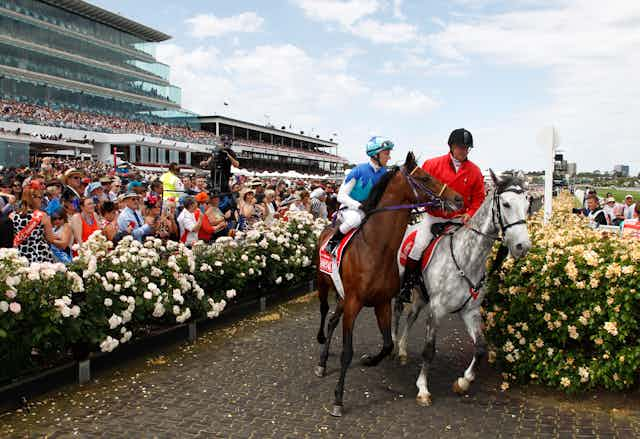It’s known as the race that stops the nation, but the Melbourne Cup carnival is about more than that. Betting and alcohol aside, it’s about two things in particular: horses and fashion.

Two motifs predominate in racing fashion: the horseshoe and the horse bit. The bit is synonymous with Gucci and Hermes; both esteemed saddlers. The motif of the horse and rider, of course, feature in the logos of Longchamp, Ralph Lauren, Longchamp and Burberry.

The single jointed snaffle bit adorns watches, bags, belts, shoes, jewellery, cufflinks and ties. Though it will adorn the ankles, waists, wrists and necks of thousands of men and women, few people give it, or the ubiquitous horseshoe, much thought.
In some ways this is a shame, because the symbolism of these objects is worth considering.

That a horseshoe motif is a recurrent symbol at a racetrack is hardly surprising. It is a metaphor for horses and the swift feet that win races for their owners and jockeys.
Echoing the shape of a crescent moon, the horseshoe is thought by some to reference Roman deities Artemis and Diana. Its luck, they say, derives from the goddess herself (or more specifically her sacred vulva). The Blessed Virgin Mary is often depicted by crescent moons or placed within vulval mandorla (the name given to the almond shape traced when two circles overlap).
In medieval Europe, pagan Moon goddesses echoing the same U shapes were frequently displayed above the doorways of medieval churches for protection. The bewitching Irish sheela-na-gig, for example, would stop the devil in his tracks by distracting him with her genitalia.
In 18th century Germany, the word “horseshoe” was slang for female genitals - the saying “to lose a horseshoe” (Sie hat ein hufeisen verloren) meaning a girl had been seduced.
Today, across Europe and the US, horseshoes are still placed above the doorways of barns and stables to ward off evil spirits.

There are however many possible origins of the lucky horseshoe. One English folkloric tale tells of Saint Dunstan, a blacksmith who when asked to shoe the devil’s horse nailed a horseshoe to the Devil’s hoof instead. When the Devil cried out in pain, Dunstan agreed to remove the shoe provided he promised never to enter a house with a horseshoe placed over its door. Charles Dickens refers to Saint Dunstan’s “red-hot tongs” in A Christmas Carol.
Debate still surrounds whether the horseshoe should face up or down. In Europe, the Middle East, Africa, India, and Latin America the rule is down; in Ireland and the US they face up.
The bit symbolises control and interference, an imposition of human will over and the appropriation of the horse’s might and power. Hung in the space between its front and back teeth, pressing on the horse’s tongue, the bit has been our default form of controlling horses for over 5,000 years.
In many ways, the mouth is to the horse as the hand is to the human. Horses explore their worlds through their mouths – feeling, licking, tasting, biting and chewing. Placing an apparatus of control in their mouths directly interferes with their ability to maintain a “horse” relationship to the world. The bit is central to literal and figural transformation of the horse from wild to tame.

These symbols do not belong solely to the domain of women’s race day attire - men wear them too in ties, cufflinks, scarves and handkerchiefs.
But the connection between horses and women, reiterated through seemingly playful yet endless linguistic puns around “fillies on the field” is quite different. Horses and women share a history of being viewed as traditional objects of male desire and pawns of male competition.

After horse races, people bid for the honour of owning the shoes worn by the winning horse. It’s an amusing quirk that as this is happening, post-race media coverage delights in following women as they gleefully trot barefooted in the grass, relieving their feet from the constraints of the modern high heel.

So what are we to make of women covering their bodies with these equine symbols of protection and control? One possible interpretation is that of the woman as powerful, dangerous and headstrong, causing men to gamble with more than their money. Perhaps this woman is in need of a bit of control.
Another reading might be of her as vulnerable to the evil spirits that lurk track side. Perhaps she requires protection in the form a crescent shaped amulet.
After all, horse racing offers its own host of dangerous characters - bookies for starters. So whether you wear a figurative heart on your sleeve these races, or a symbolic vulva, may the goddess smile upon you. After reading this, you may even be inclined to smile upon yourself.

